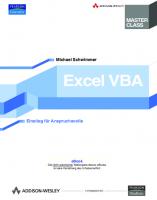VBA Guru: Master the Art of Automation: A Comprehensive VBA Guide for Finance & Accounting
Unleash the full potential of your financial analysis and reporting with 'VBA Guru'. Step beyond the basics an
170 28 3MB
English Pages 642 Year 2024
Table of contents :
Title Page
Contents
Chapter 1: Introduction to Advanced VBA in Finance
1.1 The Role of VBA in Modern Finance
1.2 Setting Up the Development Environment
1.3 Best Practices in VBA Coding
1.4 Understanding VBA Syntax and Structure
1.5 Advanced Excel Object Model
Chapter 2: Financial Data Analysis with VBA
2.1 Importing and Exporting Data
2.2 Data Cleaning and Transformation
2.3 Advanced Techniques for Data Analysis
2.4 Dynamic Reporting with VBA
2.5 Data Visualization and Charting Techniques
Chapter 3: VBA for Financial Modeling
3.1 Building Flexible Financial Models
3.2 VBA Functions for Financial Calculations
3.3 Automating Sensitivity and Scenario Analysis
3.4 Risk Analysis and Management with VBA
3.5 VBA Techniques for Optimization
Chapter 4: Automating Excel Tasks with VBA
4.1 Task Automation Basics
4.2 Advanced Workbook and Worksheet Management
4.3 Event-Driven Programming
4.4 Scheduling and Timing Tasks
4.5 Integrating Excel with Other Office Applications
Chapter 5: Error Handling and Debugging
5.1 Principles of Error Handling
5.2 Debugging Techniques for VBA
5.3 Writing Custom Error Handlers
5.4 Testing and Validation Techniques
5.5 Optimization and Performance Tuning
Chapter 6: Advanced Financial Functions and Procedures
6.1 Creating Custom Financial Functions
6.2 Complex Calculations and Algorithms
6.3 Date and Time Functions for Financial Analysis
6.4 Statistical and Mathematical Techniques
6.5 Developing Complex Financial Indicators
Conclusion
Glossary Of Terms
Additional Resources
Title Page
Contents
Chapter 1: Introduction to Advanced VBA in Finance
1.1 The Role of VBA in Modern Finance
1.2 Setting Up the Development Environment
1.3 Best Practices in VBA Coding
1.4 Understanding VBA Syntax and Structure
1.5 Advanced Excel Object Model
Chapter 2: Financial Data Analysis with VBA
2.1 Importing and Exporting Data
2.2 Data Cleaning and Transformation
2.3 Advanced Techniques for Data Analysis
2.4 Dynamic Reporting with VBA
2.5 Data Visualization and Charting Techniques
Chapter 3: VBA for Financial Modeling
3.1 Building Flexible Financial Models
3.2 VBA Functions for Financial Calculations
3.3 Automating Sensitivity and Scenario Analysis
3.4 Risk Analysis and Management with VBA
3.5 VBA Techniques for Optimization
Chapter 4: Automating Excel Tasks with VBA
4.1 Task Automation Basics
4.2 Advanced Workbook and Worksheet Management
4.3 Event-Driven Programming
4.4 Scheduling and Timing Tasks
4.5 Integrating Excel with Other Office Applications
Chapter 5: Error Handling and Debugging
5.1 Principles of Error Handling
5.2 Debugging Techniques for VBA
5.3 Writing Custom Error Handlers
5.4 Testing and Validation Techniques
5.5 Optimization and Performance Tuning
Chapter 6: Advanced Financial Functions and Procedures
6.1 Creating Custom Financial Functions
6.2 Complex Calculations and Algorithms
6.3 Date and Time Functions for Financial Analysis
6.4 Statistical and Mathematical Techniques
6.5 Developing Complex Financial Indicators
Conclusion
Glossary Of Terms
Additional Resources

- Author / Uploaded
- Sampson
- Josh; Strauss
- Johann; Van Der Post
- Hayden
- Similar Topics
- Computers
- Software: Office software









